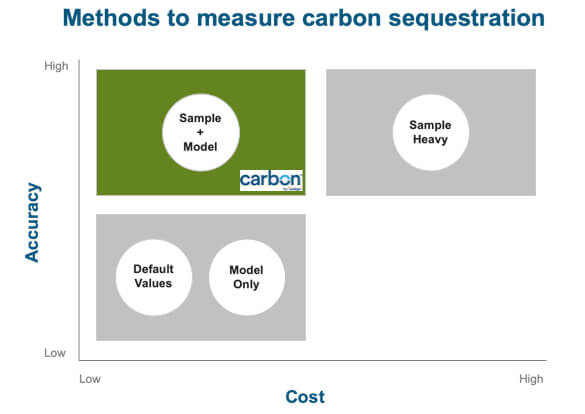Soil Organic Carbon versus Soil Organic Matter
by Johanna Cohen
It's important to understand soil organic carbon (SOC) and soil organic matter (SOM) as you create high quality carbon credits on your farm. Knowing how to interpret these two measurements will help you and your agronomist plan carbon farming practice changes that optimize profitability and soil health on your farm.

Measuring soil health through the lens of soil organic matter is common in routine soil health testing. Soil organic carbon is less familiar but essential to the generation of high-quality carbon credits in the Carbon by Indigo program. And high-quality credits mean higher payments to participating growers.
To help you understand what each of these terms mean and how to examine them, soil health experts help you breakdown these terms:
- Jose Hernandez is a Soil Scientist at Indigo, Certified Crop Advisor
- Dan Ochs is an Agricultural Economist at Indigo and a Certified Crop Advisor
How is each number calculated
Soil Organic Matter: SOM is the traditional measurement for soil fertility and is a good indicator of healthy soil. It also gives an indication of the amount of organic nitrogen that may be released in the soil and available for future crops.
Soil Organic Carbon: SOC refers only to the carbon component of organic compounds in the SOM. It allows us to calculate the carbon stock needed to measure for carbon credit generation.
How does soil sampling work at Indigo
Indigo takes soil samples from a randomized group of fields as a representative sample. That information is averaged and used to improve our carbon credit modeling. This process is similar to how management zones are developed by growers and crop consultants.

The combination of representative samples and our own quantitative modeling maintain high levels of accuracy while keeping sampling costs low. Keeping costs down and quality up means that growers receive the highest payment possible. This is what Indigo has done.
To learn more about what makes Indigo’s approach unique in the carbon market, take the free Carbon Markets & Ag course in our online course series, Carbon College.
Why is SOC relevant to you
For those growers in the program that are selected for soil sampling, Carbon by Indigo will provide those participants with a detailed soil sampling report. The SOC value included in the report can give a grower powerful insight into how a field’s carbon storage is doing. SOC levels per field are the average of multiple points on that field. SOC can vary from field to field on your operation. SOC is part of the larger goal of increasing soil fertility.
These SOC levels help determine carbon levels across fields in the program and ultimately allow for the calculation and generation of high-quality carbon credits.
Other ways to measure the impact of carbon practices on soil health:
- SOM measurement: Even if a field doesn’t get sampled again for SOC for a few years in the Carbon program, you can take the SOM on your standard soil fertility test and divide it by 2 so you can get an approximate SOC and continue to measure that value on your operation.
- Visual signs: Another great way to see how the practices are working on your operation is simply with your eyes, by looking at visual signs of carbon farming success in healthy soil.
- At-home soil tests: If you want to do some soil testing on your own, here are some inexpensive ideas to measure compaction, infiltration and erosion.
How can you improve your SOC:
- Continue your current carbon farming practice changes, expand on your current practice changes, or implement new practice changes. It can take time to repair soil that’s been farmed conventionally, especially when moving from conventional tillage to no-till.
- One of the best ways to start increasing SOC early is by planting cover crops. Cover crops combined with no-till over time will generate the highest payments.
How can SOC and SOM help your agronomist
Since an increase in SOM also leads to an increased SOC, you can use either your Indigo soil sampling report or your own soil fertility report and discuss how to optimize these levels with your agronomist.
Your SOC measure (or SOM divided by 2) can help you and your agronomist get a picture of the impact of practices on SOC and SOM. This is the best time to have a conversation with your agronomist on ways to adjust or expand practices.
A carbon farming expert is a click away. Simply chat with us using the chat box on the bottom right of your screen.
Ready to test out different practice change scenarios for your operation? Click below. When you want to test out different scenarios of increasing payment based on practice changes, you can build test plans that show you practice impact on profitability.
By Johanna Cohen - Product Marketer for Sustainability Products at Indigo
This article may include information from third-party sources or other information that Indigo may not independently verify. Carbon quantification methods, processes and understandings are in their nascency and subject to change and continuous development. The information contained herein is for general informational purposes only and may be based on generally applicable assumptions that may not be applicable to any individual operation. Actual results may differ among growers and farms based on a large number of variables. Each operation should independently consider the financial implications and all potential risks and benefits of the use of any agronomic practice. Any payments under Carbon by Indigo are subject to multi-year vesting and are contingent on continued long-term maintenance of regenerative agricultural practices and soil carbon levels. All Carbon Credits generated are subject to buffer pool holdbacks required by third-party crediting; participants will not receive payments for such holdback. Neither Indigo nor its representatives or affiliates makes any representations, warranties or guarantees as to any specific outcomes (agronomic, financial or otherwise) in connection with any recommendations, calculations or predictions. Terms, conditions, limitations and eligibility requirements apply. See program agreement for additional details regarding Carbon by Indigo.
Farmers like you are getting paid to implement practices that improve soil health. With skyrocketing input costs, see how covers help.
You might also be interested in:
Neither Indigo nor any of its affiliates makes any representations, warranties or guarantees as to any specific results or outcomes, including, without limitation, with respect to soil health outcomes or any minimum amount of greenhouse gasses sequestered or number of carbon credits generated. Participation in Carbon by Indigo is subject to the terms, conditions and limitations of the program contained in the applicable enrollment agreement. Any payments under Carbon by Indigo are subject to multi-year vesting and are contingent on continued long-term maintenance of regenerative agricultural practices and soil carbon levels. All Carbon Credits generated are subject to buffer pool holdbacks required by third-party crediting; participants will not receive payments for such holdback. Not available in all areas.
500 Rutherford Ave, Boston, MA 02129 | 844.828.0240 | info@indigoag.com